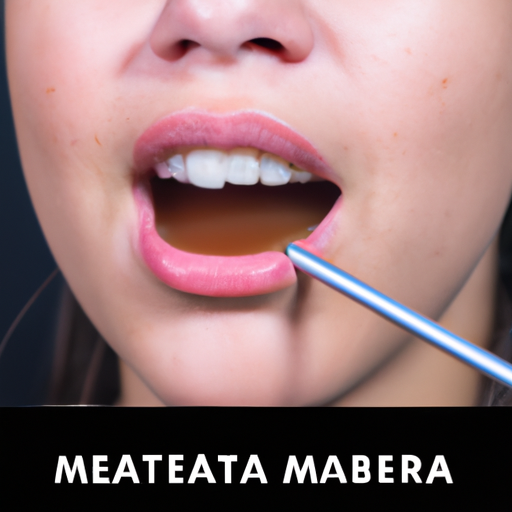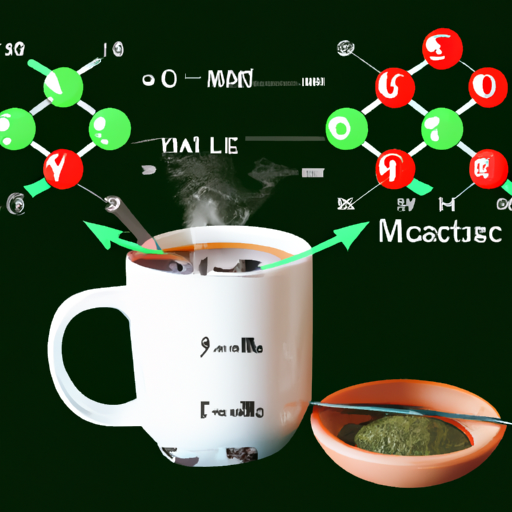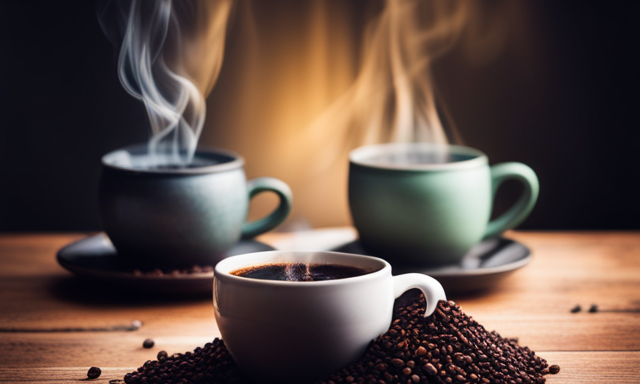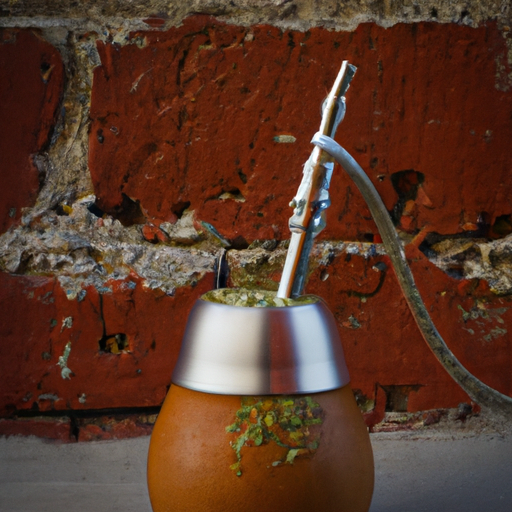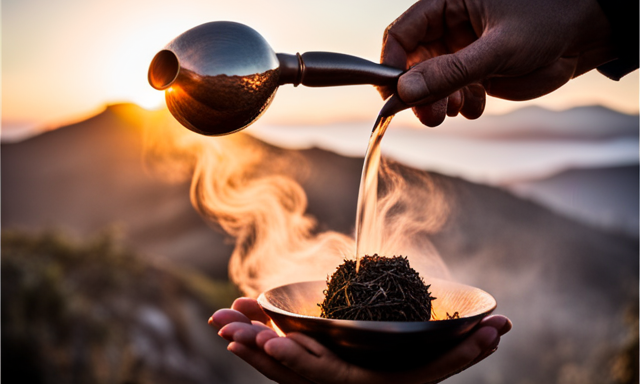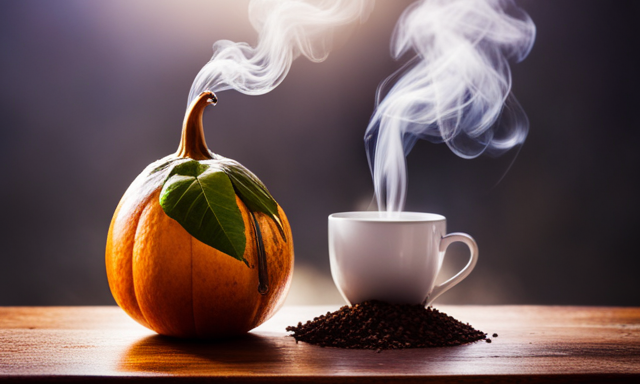So, you’ve been enjoying yerba mate for some time. You appreciate its flavor, the surge of energy it provides, and the communal experience of sharing it with pals. However, there’s one issue – you’re uncertain about the correct way to say its name.
Is it ‘yer-buh mah-tay’? ‘Yer-buh mayt’? Or maybe something else entirely?
Well, fear not my fellow mate-drinkers, because I’m here to guide you through the murky waters of yerba mate pronunciation. As someone who’s been drinking this magical beverage for years (and has definitely butchered the pronunciation a few times), I can assure you that getting it right is crucial – not only for your own confidence, but also for showing respect to the culture from which yerba mate originated.
So let’s dive in and figure out once and for all how to properly say ‘yerba mate.’
Key Takeaways
- Yerba mate is a traditional South American drink with many health benefits, consumed for centuries by indigenous peoples.
- The correct pronunciation of yerba mate is ‘yer-bah mah-teh’, with regional variations in pronunciation due to cultural differences.
- Proper pronunciation shows respect for the cultural significance of yerba mate, and etiquette and traditions should be respected when preparing and consuming it.
- Understanding and respecting cultural differences is crucial in cross-cultural communication and building connections across cultures.
Background on Yerba Mate
You’re probably curious about the background of yerba mate, so let me tell you – it’s a traditional South American drink made from dried leaves and twigs that are steeped in hot water to create an earthy, herbal infusion.
Yerba mate has been consumed for centuries by indigenous peoples in Argentina, Uruguay, Paraguay, and southern Brazil as a social and cultural tradition. It is considered to be an important part of their daily life.
In addition to its cultural significance, yerba mate also offers numerous health benefits. It contains caffeine and other stimulants that can help improve mental alertness and focus. It is also rich in antioxidants which can aid in reducing inflammation and preventing chronic diseases such as heart disease, cancer, and diabetes. Moreover, yerba mate is known for its ability to boost the immune system due to the presence of compounds like saponins and polyphenols.
Traditionally prepared with a gourd (a hollowed-out pumpkin) called a mate or guampa in Spanish or Portuguese respectively, yerba mate is enjoyed by placing the dried leaves into the gourd cup first before adding hot water. The drink is then sipped through a metal straw called a bombilla which filters out any loose leaves or twigs. This traditional preparation method has been passed down from generation to generation among South American cultures.
Now that we’ve explored the history behind this unique beverage along with its many health benefits and traditional preparation methods, let’s move on to common mispronunciations of this word.
Common Mispronunciations
I’ll now discuss common mispronunciations of the word ‘yerba mate’ and the reasons for these errors.
As someone who’s studied the language and culture surrounding yerba mate, I’ve noticed several popular mispronunciations. For example, ‘yerba mahtay’ or ‘yurba mate.’ These errors can stem from a lack of familiarity with Spanish pronunciation or confusion stemming from regional dialects.
Popular Mispronunciations
There’s a common mispronunciation of yerba mate that many people tend to make. It’s not just a matter of adding an accent or two, but rather, it’s a fundamental issue about the sounds involved in the word itself.
Yerba Mate pronunciation controversies abound because there are regional variations in Yerba Mate pronunciation across South America and beyond. One popular mispronunciation is ‘yer-buh mayt’. This version replaces the trilled ‘r’ sound with a soft ‘b’, which changes the meaning of the word entirely. Another one is ‘yur-buh maht’, which misses out on the strong emphasis on the first syllable and adds an ‘h’ sound at the end. While these versions might be easier for English speakers to say, they don’t quite capture what makes yerba mate unique.
This points to one reason why mispronunciations happen: unfamiliarity with Spanish sounds and intonation patterns. As someone who grew up speaking Spanish, I find myself correcting friends who pronounce it incorrectly all the time. But even within Latin America, there are differences in how people say it depending on where they come from!
Reasons for Mispronunciations
Oh, great, let’s just keep butchering the pronunciation of this beloved beverage because we can’t be bothered to learn how to properly articulate foreign sounds. Mispronunciations of yerba mate are common and often due to a lack of exposure or understanding of the language it originates from.
Here are some common causes for mispronunciations:
- Regional Variations: Different regions may have their own way of pronouncing certain words, which can lead to confusion.
- Lack of Exposure: If someone hasn’t heard the correct pronunciation before, they may struggle to say it correctly.
- Cultural Significance: Yerba mate is an important cultural symbol in many South American countries, which means there may be pressure to pronounce it correctly.
- Language Barriers: Some people may not speak Spanish fluently, making it difficult for them to understand how the word is supposed to sound.
However, there are tips for improvement that can help you pronounce yerba mate more accurately. In the next section, I’ll discuss the correct pronunciation and provide guidance on how you can improve your own pronunciation skills.
The Correct Pronunciation
To sound like a true mate connoisseur, it’s important to know that the proper enunciation of yerba mate is ‘yer-bah mah-teh.’ While there may be regional variations in how it’s pronounced, this is the most widely accepted way to say it.
It’s also important to note that the emphasis should be on the second syllable, as opposed to the first. In Argentina and Uruguay, where yerba mate is a popular drink, ‘mah-teh’ is sometimes pronounced with a more open ‘e’ sound than in other Spanish-speaking countries.
However, regardless of where you are or who you’re speaking with, using the correct pronunciation shows respect for the culture and tradition surrounding this beloved beverage.
Moving on to phonetic breakdown of yerba mate…
Phonetic Breakdown of Yerba Mate
Understanding the phonetic breakdown of this beloved beverage can help you appreciate the intricacies of yerba mate’s pronunciation and deepen your connection to its cultural significance. Yerba mate is a South American drink made from dried leaves and twigs of the Ilex paraguariensis plant, and it has gained popularity worldwide due to its unique taste and various health benefits.
However, many people struggle with pronouncing it correctly, especially those who aren’t familiar with Spanish or Portuguese languages. Here’s a breakdown of how to pronounce yerba mate:
- The first syllable ‘yer’ sounds like ‘jer’ in English.
- The second syllable ‘ba’ is pronounced as ‘buh’.
- The third syllable ‘ma’ sounds like ‘mah’.
- Finally, the last syllable ‘te’ is pronounced like ‘tay’.
Despite these guidelines, there are still some pronunciation difficulties that may arise due to regional accents. For example, in Argentina and Uruguay where yerba mate is consumed extensively, people tend to pronounce it differently than in Brazil or Paraguay where Portuguese or Guarani languages are spoken respectively. Additionally, some people may add stress on different parts of the word which can cause confusion for non-native speakers.
Understanding how to properly pronounce yerba mate can enhance your appreciation for this beloved beverage while also increasing your cultural awareness. Although there may be regional variations in pronunciation and stress patterns, following the basic phonetic breakdown will ensure that you can communicate effectively when ordering or discussing yerba mate with others who share your passion for this unique drink.
Now let’s explore how yerba mate compares to other popular beverages around the world!
Comparing Yerba Mate to Other Beverages
When it comes to comparing yerba mate to other beverages, there are some key differences in pronunciation that should be noted.
As someone who’s tried many different drinks in my lifetime, I’ve noticed that it can be easy to make common mistakes when comparing pronunciations between them.
For example, the way you pronounce "mate"might differ from how you’d say "tea"or "coffee,"leading to confusion for those who aren’t familiar with yerba mate specifically.
Differences in Pronunciation
Did you know that depending on where you’re from, the pronunciation of yerba mate can vary? Pronunciation variations exist due to regional differences.
The Argentinians and Uruguayans tend to pronounce it as ‘sher-ba mah-teh’, while the Brazilians say ‘yer-bah mah-tay’, emphasizing the ‘r’ sound.
It’s important to note that both pronunciations are correct and accepted in their respective regions. However, if you want to avoid any confusion while traveling or interacting with people from different countries, it’s best to learn both pronunciations.
In the end, no matter how you pronounce it, enjoying a cup of yerba mate is what really matters!
Now let’s move onto common mistakes when comparing pronunciations.
Common Mistakes When Comparing Pronunciations
In the previous subtopic, we discussed the differences in pronunciation of yerba mate. However, it’s important to note that there are common mistakes people make when comparing these pronunciations due to regional variations.
Here are some common pronunciation mistakes to be aware of:
- Pronouncing the ‘y’ in yerba as a hard ‘y’ like in ‘yellow’ instead of a soft ‘j’ like in ‘hallelujah’.
- Emphasizing the first syllable of mate instead of the second syllable.
- Pronouncing mate with a long ‘a’ sound like in ‘wait’ instead of a short ‘a’ sound like in ‘cat’.
- Saying yerba with too much emphasis on the last syllable instead of evenly distributing emphasis throughout all three syllables.
- Not rolling or trilling the ‘r’ sound properly.
It’s important to keep these common mistakes in mind when attempting to pronounce yerba mate correctly. By being aware of these errors, you can improve your own pronunciation and avoid embarrassing mispronunciations.
Moving forward, one way to improve your pronunciation is by listening to audio recordings or YouTube videos. These resources provide examples from native speakers and can help you practice correct pronunciation.
Youtube Videos and Audio Recordings
Hey, have y’all checked out any of them YouTube vids or audio recordings on how to pronounce yerba mate? It’s totally lit! As someone who has struggled with the pronunciation of this popular South American beverage, I found these resources to be incredibly helpful in exploring regional variations and overcoming linguistic challenges for non-native speakers.
One video that particularly stood out was from a native Argentinian speaker who provided a detailed breakdown of the correct way to say "yerba mate"using both English and Spanish phonetics. The video also included tips on accentuation and intonation, which are important factors when trying to sound like a local. Similarly, there are many audio recordings available online that allow you to listen and practice the pronunciation at your own pace.
To help illustrate the different pronunciations across various regions, here’s a table outlining some common variations:
| Region | Pronunciation |
|---|---|
| Argentina | Ê’eɾβa ‘matʃe |
| Uruguay | ʃerβa ‘mate |
| Paraguay | jeɾβa ‘mate |
| Brazil | ʤe’ɾba ‘mat͡ʃi |
With these resources at hand, it’s easier than ever before to master the correct pronunciation of yerba mate. However, knowing how to say it correctly is only one piece of the puzzle – next up is navigating social situations where you may encounter this drink.
Pronunciation in Social Situations
When ordering yerba mate in Spanish, it’s important to know how to pronounce the words correctly in order to avoid any confusion or misunderstandings.
To make sure you’re pronouncing yerba mate properly in conversations with native speakers, it can be helpful to practice beforehand and listen carefully to their pronunciation as well.
Here are some tips for confidently ordering and discussing yerba mate in social situations.
How to Order Yerba Mate in Spanish
To order yerba mate in Spanish, you can say ‘quiero un mate de yerba’ or ‘dame un mate con yerba.’
When ordering yerba mate in a Spanish-speaking country, it’s important to follow the ordering etiquette and cultural symbolism associated with this traditional beverage. Here are three tips to keep in mind:
-
Use polite language: When asking for a cup of yerba mate, make sure to use polite language and address the person serving you with respect. This’ll help ensure that your request is received positively.
-
Specify your preferences: Be clear about how you want your yerba mate prepared – do you want it hot or cold? Would you like any sweeteners added? Most importantly, specify the amount of yerba leaves that should be used for brewing.
-
Respect cultural traditions: Yerba mate is often shared among friends and family members as a sign of hospitality and friendship. If someone offers to share their cup of mate with you, it’s considered impolite to refuse.
In order to fully immerse yourself in Spanish-speaking culture and enjoy all its traditions, it’s important to learn how to pronounce words correctly. In the next section, I’ll share some tips for pronouncing ‘yerba mate’ in conversations without feeling self-conscious or unsure.
Tips for Pronouncing Yerba Mate in Conversations
Learning the correct pronunciation of yerba mate is crucial for fully immersing yourself in Spanish-speaking culture and avoiding any self-consciousness or uncertainty during conversations. While it may seem like a simple task, many non-native speakers struggle with the unique sounds and regional variations present in the pronunciation of this traditional beverage.
One of the main challenges when pronouncing yerba mate is getting the stress on the correct syllable. In Spanish, stress usually falls on the second to last syllable, but with yerba mate, it falls on the first syllable. This can be difficult for English speakers who are used to placing emphasis on different parts of words. Additionally, there are regional variations in pronunciation that can further complicate things. For example, in Argentina and Uruguay, where yerba mate is most popular, people tend to drop the final "e"sound and pronounce it more like "yerba mat."However, in other countries such as Paraguay and Brazil, they may pronounce it with a longer "a"sound or emphasize different syllables.
| Pronunciation Challenge | Explanation |
|---|---|
| Stress Placement | Stress falls on first syllable instead of second-to-last |
| Regional Variations | Different countries have differing pronunciations |
As you navigate through conversations about yerba mate, keep these pronunciation challenges in mind and try to practice saying it correctly by listening to native speakers or repeating after them. With time and effort put into mastering its pronunciation nuances, you’ll find that you’re able to speak confidently about this beloved beverage without hesitation. Moving forward into common phrases related to yerba mate…
Common Phrases Related to Yerba Mate
Believe it or not, even if you’ve never heard of yerba mate before, chances are that you’ve probably already uttered some of the common phrases associated with this beloved South American beverage.
Some of these phrases include ‘cebando mate,’ which means to prepare and serve yerba mate to others, and ‘mate amargo,’ which refers to unsweetened yerba mate.
Apart from these basic phrases, there are several other terms used in connection with yerba mate that are worth knowing. For instance, ‘bombilla’ is the metal straw used for drinking the beverage, while ‘gourd’ refers to the hollowed-out container in which the tea is traditionally served. Additionally, ‘tereré’ is a cold version of yerba mate that’s popular in Paraguay during hot weather.
Knowing these terms can be useful when ordering or discussing yerba mate with others. However, it’s important to note that there’s much more to this drink than just its vocabulary – it also boasts numerous health benefits and unique preparation techniques.
Understanding how best to prepare yerba mate involves learning about different methods such as using a French press or gourd and bombilla set. Meanwhile, health benefits include boosted energy levels thanks to caffeine and other natural stimulants present in the tea leaves.
All of these aspects contribute towards making yerba mate a truly remarkable beverage with many cultural significances beyond just pronunciation.
Cultural Significance of Pronunciation
Now that we’ve gone over some common phrases related to yerba mate, let’s talk about something equally as important: how to properly pronounce it. As someone who’s grown up drinking yerba mate, I can attest to the fact that there are many different ways people say it. In fact, the pronunciation can vary quite significantly depending on which Spanish speaking country you come from.
First and foremost, it’s important to understand that the correct pronunciation of yerba mate is ‘yer-bah mah-teh.’ However, this isn’t always how the word is pronounced in every Spanish speaking country. For example, in Argentina, where yerba mate is extremely popular, they tend to drop the final ‘e’ sound and say ‘yer-bah mat.’ On the other hand, in Paraguay, they add an extra syllable and say ‘yer-bah mah-tay-ee.’
It may seem like a small thing, but mispronouncing cultural words such as yerba mate can have a big impact on communication. It can lead to confusion or misunderstandings, especially if you’re traveling or interacting with people from different countries. Additionally, pronouncing words correctly shows respect for the culture and language of others.
To ensure proper communication and show respect for cultural differences when discussing yerba mate (or any other cultural topic), it’s crucial to understand variations in pronunciation among different Spanish speaking countries. By taking the time to learn these nuances and practicing correct pronunciation yourself, you’ll be well on your way to having meaningful conversations and building connections across cultures.
Frequently Asked Questions
What are the health benefits of drinking yerba mate?
As someone who’s extensively researched the topic, I can confidently say that drinking yerba mate has numerous health benefits.
Yerba Mate Varieties vary in their composition and preparation, but they all contain high levels of antioxidants, vitamins, and minerals that promote overall wellbeing.
One of the most significant benefits is its ability to aid in weight loss as it contains compounds that boost metabolism and reduce appetite.
Additionally, yerba mate has been known to improve mental clarity and focus while reducing stress levels.
Its caffeine content provides a natural energy boost without the jitters often associated with coffee consumption.
Overall, incorporating yerba mate into your daily routine can provide a range of health benefits that contribute to overall wellness.
How is yerba mate traditionally consumed in South America?
Yerba mate is traditionally consumed in South America by using a gourd and a metal straw called a bombilla. The gourd is filled with yerba mate leaves and hot water, then sipped through the bombilla.
It’s important to follow gourd etiquette by not moving the bombilla around and not stirring the drink. Sharing rituals are also an important part of yerba mate culture. One person prepares the drink and passes it around to be shared among friends or family members.
This communal act symbolizes friendship, trust, and unity. Overall, drinking yerba mate in this traditional manner promotes socialization and relaxation while providing numerous health benefits.
What is the history of yerba mate and its cultural significance?
When I think about the cultural roots and social customs surrounding yerba mate, I’m reminded of a story my Argentinean friend shared with me. He explained that in his hometown, sharing yerba mate is seen as a symbol of friendship and community.
Every morning, families and friends gather together to drink mate and catch up on each other’s lives. This ritual has deep historical significance in South America, dating back to indigenous tribes who used it for medicinal purposes before it became an important part of their social traditions.
Today, drinking yerba mate remains an integral part of the region’s culture and lifestyle. Its cultural significance extends beyond just consuming the beverage; it represents a way of life that values connection with others and cherishes community bonds. Through this tradition, people learn to share and care for one another in meaningful ways- something that’s rare in today’s fast-paced world.
Overall, understanding the history behind yerba mate can give us insights into how cultures evolve over time and how we can preserve our traditions while adapting to changes around us.
Are there any negative side effects of drinking yerba mate?
There are potential negative side effects associated with drinking yerba mate, particularly for individuals who are caffeine sensitive or have digestive issues. Yerba mate contains caffeine, which can cause jitters, anxiety, and insomnia in some people. It may also exacerbate existing digestive problems such as acid reflux or irritable bowel syndrome.
However, these side effects vary from person to person and may not affect everyone who consumes yerba mate. It’s important to monitor your body’s reaction to the drink and speak with a healthcare professional if you experience any adverse effects.
How can I prepare yerba mate at home?
When it comes to preparing yerba mate at home, there are a few things you need to consider. First of all, you’ll need to choose the type of yerba mate that you want to use. There are many different herbal blends available, so you can experiment and find the one that suits your taste best.
Once you’ve got your blend sorted, it’s time to start brewing! The traditional way is to use a gourd and bombilla (a special straw), but you can also use a French press or tea infuser if you prefer. Heat up some water (not boiling) and add it slowly over the yerba mate leaves, allowing them to steep for a few minutes before enjoying.
It’s important not to let the water boil as this can affect the flavor of the drink. With these brewing techniques under your belt, you’ll be able to enjoy homemade yerba mate whenever you like!
Conclusion
In conclusion, learning the correct pronunciation of yerba mate isn’t just important for communicating accurately but also for respecting its cultural significance. As someone who’s struggled with mispronouncing it, I can attest to the awkwardness and confusion that can arise from saying it incorrectly.
For example, I once ordered a ‘yer-buh mate’ at a café and was met with a puzzled look from the barista. It wasn’t until they corrected me by saying ‘yehr-bah mah-teh’ that I realized my mistake.
By taking the time to properly learn how to say yerba mate, not only did I avoid potential embarrassment in social situations but I also gained a deeper appreciation for its origins and cultural importance.
Whether you’re a seasoned yerba mate drinker or new to this energizing beverage, taking the time to learn its correct pronunciation is essential. So next time you’re at a café or sharing your love for yerba mate with friends, be sure to confidently say ‘yehr-bah mah-teh’ and show respect for this cherished South American tradition.

